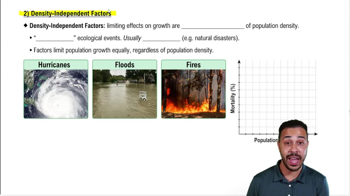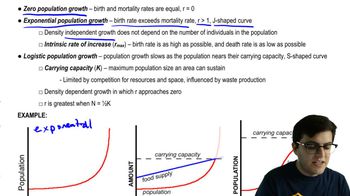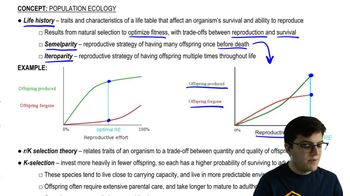Table of contents
- 1. Introduction to Biology2h 40m
- 2. Chemistry3h 40m
- 3. Water1h 26m
- 4. Biomolecules2h 23m
- 5. Cell Components2h 26m
- 6. The Membrane2h 31m
- 7. Energy and Metabolism2h 0m
- 8. Respiration2h 40m
- 9. Photosynthesis2h 49m
- 10. Cell Signaling59m
- 11. Cell Division2h 47m
- 12. Meiosis2h 0m
- 13. Mendelian Genetics4h 41m
- Introduction to Mendel's Experiments7m
- Genotype vs. Phenotype17m
- Punnett Squares13m
- Mendel's Experiments26m
- Mendel's Laws18m
- Monohybrid Crosses16m
- Test Crosses14m
- Dihybrid Crosses20m
- Punnett Square Probability26m
- Incomplete Dominance vs. Codominance20m
- Epistasis7m
- Non-Mendelian Genetics12m
- Pedigrees6m
- Autosomal Inheritance21m
- Sex-Linked Inheritance43m
- X-Inactivation9m
- 14. DNA Synthesis2h 27m
- 15. Gene Expression3h 20m
- 16. Regulation of Expression3h 31m
- Introduction to Regulation of Gene Expression13m
- Prokaryotic Gene Regulation via Operons27m
- The Lac Operon21m
- Glucose's Impact on Lac Operon25m
- The Trp Operon20m
- Review of the Lac Operon & Trp Operon11m
- Introduction to Eukaryotic Gene Regulation9m
- Eukaryotic Chromatin Modifications16m
- Eukaryotic Transcriptional Control22m
- Eukaryotic Post-Transcriptional Regulation28m
- Eukaryotic Post-Translational Regulation13m
- 17. Viruses37m
- 18. Biotechnology2h 58m
- 19. Genomics17m
- 20. Development1h 5m
- 21. Evolution3h 1m
- 22. Evolution of Populations3h 52m
- 23. Speciation1h 37m
- 24. History of Life on Earth2h 6m
- 25. Phylogeny2h 31m
- 26. Prokaryotes4h 59m
- 27. Protists1h 12m
- 28. Plants1h 22m
- 29. Fungi36m
- 30. Overview of Animals34m
- 31. Invertebrates1h 2m
- 32. Vertebrates50m
- 33. Plant Anatomy1h 3m
- 34. Vascular Plant Transport2m
- 35. Soil37m
- 36. Plant Reproduction47m
- 37. Plant Sensation and Response1h 9m
- 38. Animal Form and Function1h 19m
- 39. Digestive System10m
- 40. Circulatory System1h 57m
- 41. Immune System1h 12m
- 42. Osmoregulation and Excretion50m
- 43. Endocrine System4m
- 44. Animal Reproduction2m
- 45. Nervous System55m
- 46. Sensory Systems46m
- 47. Muscle Systems23m
- 48. Ecology3h 11m
- Introduction to Ecology20m
- Biogeography14m
- Earth's Climate Patterns50m
- Introduction to Terrestrial Biomes10m
- Terrestrial Biomes: Near Equator13m
- Terrestrial Biomes: Temperate Regions10m
- Terrestrial Biomes: Northern Regions15m
- Introduction to Aquatic Biomes27m
- Freshwater Aquatic Biomes14m
- Marine Aquatic Biomes13m
- 49. Animal Behavior28m
- 50. Population Ecology3h 41m
- Introduction to Population Ecology28m
- Population Sampling Methods23m
- Life History12m
- Population Demography17m
- Factors Limiting Population Growth14m
- Introduction to Population Growth Models22m
- Linear Population Growth6m
- Exponential Population Growth29m
- Logistic Population Growth32m
- r/K Selection10m
- The Human Population22m
- 51. Community Ecology2h 46m
- Introduction to Community Ecology2m
- Introduction to Community Interactions9m
- Community Interactions: Competition (-/-)38m
- Community Interactions: Exploitation (+/-)23m
- Community Interactions: Mutualism (+/+) & Commensalism (+/0)9m
- Community Structure35m
- Community Dynamics26m
- Geographic Impact on Communities21m
- 52. Ecosystems2h 36m
- 53. Conservation Biology24m
50. Population Ecology
Introduction to Population Ecology
Problem 12b
Textbook Question
Textbook QuestionBurmese pythons (Python molurus bivittatus) are constricting snakes that can reach enormous sizes (up to 7 meters in length). They are native to Southeast Asia but were released into southern Florida from the pet trade. Many other snakes occur naturally in this area. Are the introduced pythons a problem? Researchers hypothesize that the severe winter of 2010 caused the decline in the number of pythons encountered that year. Is cold weather typically a density-dependent factor or a density-independent factor? Explain the difference.
 Verified step by step guidance
Verified step by step guidance1
Step 1: Understand the problem: The first part of the problem is asking whether the introduced Burmese pythons in southern Florida are a problem. This is a subjective question and can be answered based on the potential impact of these pythons on the local ecosystem, such as competition with native species, predation on native species, and potential to disrupt the balance of the ecosystem.
Step 2: Formulate a hypothesis: Based on the information given, one could hypothesize that the introduced pythons could be a problem if they outcompete native species for resources or become a significant predator of native species. This could lead to a decrease in biodiversity and disrupt the balance of the ecosystem.
Step 3: Understand the second part of the problem: The second part of the problem is asking whether cold weather is typically a density-dependent or density-independent factor. Density-dependent factors are those that affect the population size in relation to the population's density, such as competition, predation, and disease. Density-independent factors are those that affect the population size regardless of the population's density, such as weather, natural disasters, and human activities.
Step 4: Formulate a hypothesis: Cold weather is typically a density-independent factor because it can affect the population size regardless of the population's density. For example, a severe winter can cause a decline in the number of pythons regardless of how many pythons there are to begin with.
Step 5: Explain the difference: The main difference between density-dependent and density-independent factors is that density-dependent factors change in effectiveness (the impact on population size) as the population density changes. In contrast, density-independent factors affect the population size regardless of the population density.
Recommended similar problem, with video answer:
 Verified Solution
Verified SolutionThis video solution was recommended by our tutors as helpful for the problem above
Video duration:
1mPlay a video:
Was this helpful?
Key Concepts
Here are the essential concepts you must grasp in order to answer the question correctly.
Density-Dependent Factors
Density-dependent factors are environmental influences that affect population growth in relation to the population's density. These factors, such as food availability, predation, and disease, become more significant as the population increases. For example, in a crowded environment, competition for resources intensifies, leading to higher mortality rates or lower birth rates. Understanding these factors is crucial for assessing how populations respond to changes in their environment.
Recommended video:
Guided course

Density-Dependent Factors
Density-Independent Factors
Density-independent factors are environmental influences that impact population size regardless of the population's density. These factors include natural disasters, climate changes, and extreme weather events, such as cold winters or droughts. For instance, a severe winter can reduce the survival of a species without regard to how many individuals are present in the population. Recognizing these factors helps in understanding population dynamics in relation to environmental changes.
Recommended video:
Guided course

Density-Independent Factors
Population Dynamics
Population dynamics refers to the study of how and why populations change over time, influenced by various factors including birth rates, death rates, immigration, and emigration. It encompasses both density-dependent and density-independent factors, providing insights into the growth patterns and sustainability of species. In the context of Burmese pythons in Florida, understanding population dynamics is essential to evaluate the impact of introduced species and environmental conditions on native ecosystems.
Recommended video:
Guided course

Community Dynamics Example 1

 1:17m
1:17mWatch next
Master Population Ecology with a bite sized video explanation from Jason Amores Sumpter
Start learningRelated Videos
Related Practice



































































